Business Level Strategies and Leadership: A Comprehensive Report
VerifiedAdded on 2020/03/16
|11
|2986
|56
Report
AI Summary
This report delves into the realm of business level strategies, crucial for achieving organizational targets and profitability. It defines business level strategy, outlining various types such as cost leadership, differentiation, and focus strategies, emphasizing their significance in gaining a sustainable competitive advantage. The report explains the strategic management process, highlighting Michael Porter's generic strategic model and its core strategies. It explores how these strategies provide customer value and exploit core competencies. The report further discusses the importance of cost leadership, differentiation, and focus strategies, analyzing their roles in market positioning, competitive benefits, and innovation. It examines the impact of these strategies on price, quality, and customer satisfaction, emphasizing the need for a balance between these elements. The report also examines the role of the Porter's five forces model. Finally, the report discusses integrated cost leadership/differentiation strategy, emphasizing the importance of providing unique value to customers while maintaining low costs.
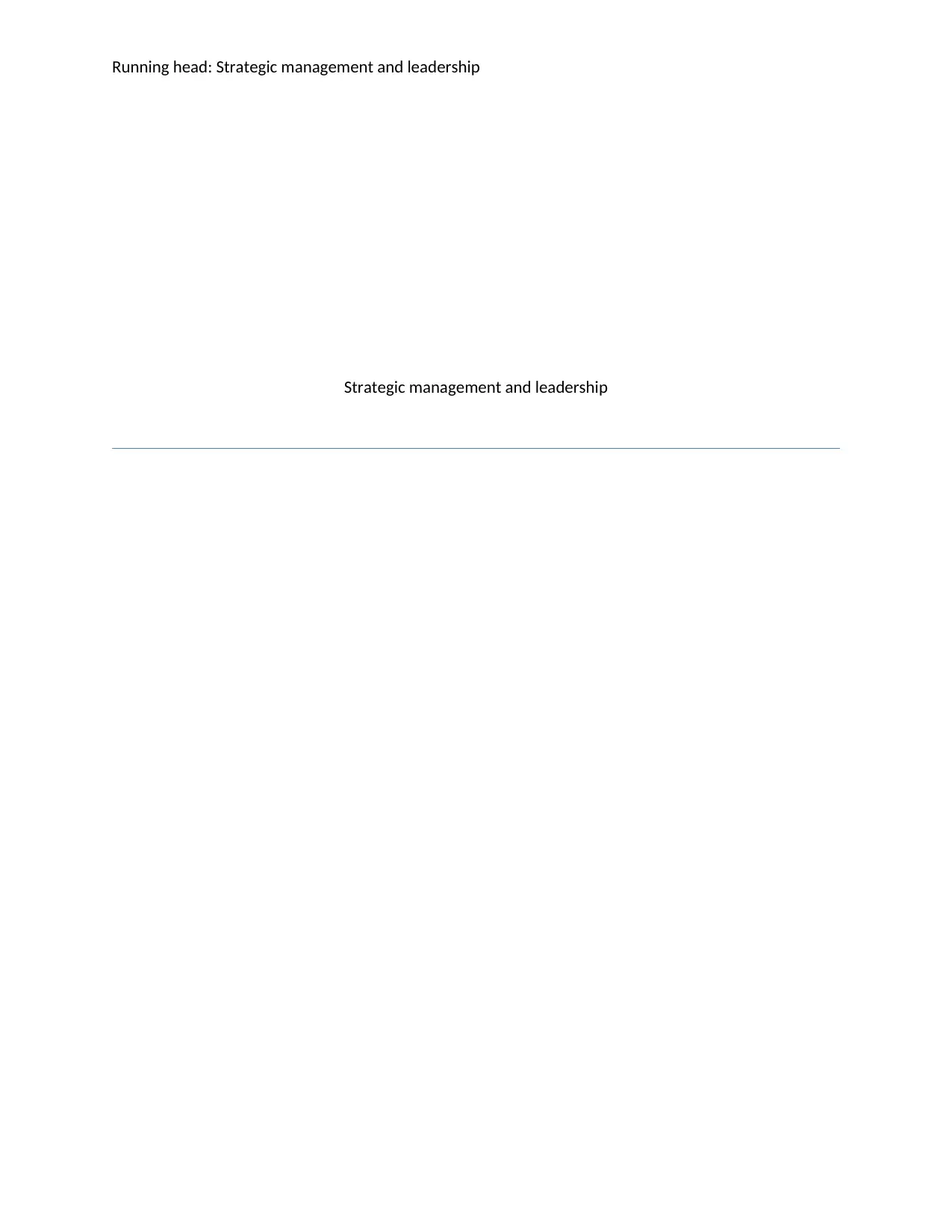
Running head: Strategic management and leadership
Strategic management and leadership
Strategic management and leadership
Paraphrase This Document
Need a fresh take? Get an instant paraphrase of this document with our AI Paraphraser
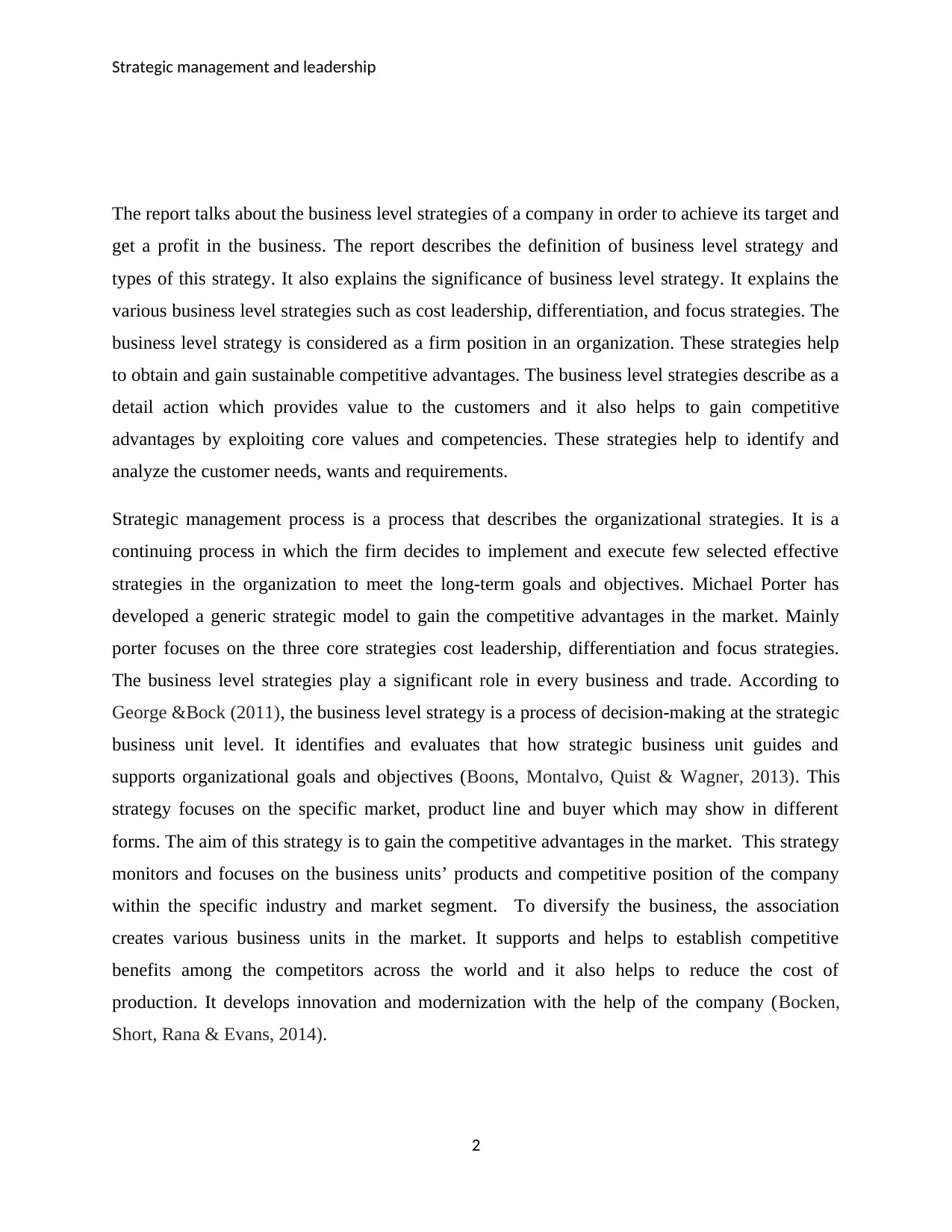
Strategic management and leadership
The report talks about the business level strategies of a company in order to achieve its target and
get a profit in the business. The report describes the definition of business level strategy and
types of this strategy. It also explains the significance of business level strategy. It explains the
various business level strategies such as cost leadership, differentiation, and focus strategies. The
business level strategy is considered as a firm position in an organization. These strategies help
to obtain and gain sustainable competitive advantages. The business level strategies describe as a
detail action which provides value to the customers and it also helps to gain competitive
advantages by exploiting core values and competencies. These strategies help to identify and
analyze the customer needs, wants and requirements.
Strategic management process is a process that describes the organizational strategies. It is a
continuing process in which the firm decides to implement and execute few selected effective
strategies in the organization to meet the long-term goals and objectives. Michael Porter has
developed a generic strategic model to gain the competitive advantages in the market. Mainly
porter focuses on the three core strategies cost leadership, differentiation and focus strategies.
The business level strategies play a significant role in every business and trade. According to
George &Bock (2011), the business level strategy is a process of decision-making at the strategic
business unit level. It identifies and evaluates that how strategic business unit guides and
supports organizational goals and objectives (Boons, Montalvo, Quist & Wagner, 2013). This
strategy focuses on the specific market, product line and buyer which may show in different
forms. The aim of this strategy is to gain the competitive advantages in the market. This strategy
monitors and focuses on the business units’ products and competitive position of the company
within the specific industry and market segment. To diversify the business, the association
creates various business units in the market. It supports and helps to establish competitive
benefits among the competitors across the world and it also helps to reduce the cost of
production. It develops innovation and modernization with the help of the company (Bocken,
Short, Rana & Evans, 2014).
2
The report talks about the business level strategies of a company in order to achieve its target and
get a profit in the business. The report describes the definition of business level strategy and
types of this strategy. It also explains the significance of business level strategy. It explains the
various business level strategies such as cost leadership, differentiation, and focus strategies. The
business level strategy is considered as a firm position in an organization. These strategies help
to obtain and gain sustainable competitive advantages. The business level strategies describe as a
detail action which provides value to the customers and it also helps to gain competitive
advantages by exploiting core values and competencies. These strategies help to identify and
analyze the customer needs, wants and requirements.
Strategic management process is a process that describes the organizational strategies. It is a
continuing process in which the firm decides to implement and execute few selected effective
strategies in the organization to meet the long-term goals and objectives. Michael Porter has
developed a generic strategic model to gain the competitive advantages in the market. Mainly
porter focuses on the three core strategies cost leadership, differentiation and focus strategies.
The business level strategies play a significant role in every business and trade. According to
George &Bock (2011), the business level strategy is a process of decision-making at the strategic
business unit level. It identifies and evaluates that how strategic business unit guides and
supports organizational goals and objectives (Boons, Montalvo, Quist & Wagner, 2013). This
strategy focuses on the specific market, product line and buyer which may show in different
forms. The aim of this strategy is to gain the competitive advantages in the market. This strategy
monitors and focuses on the business units’ products and competitive position of the company
within the specific industry and market segment. To diversify the business, the association
creates various business units in the market. It supports and helps to establish competitive
benefits among the competitors across the world and it also helps to reduce the cost of
production. It develops innovation and modernization with the help of the company (Bocken,
Short, Rana & Evans, 2014).
2
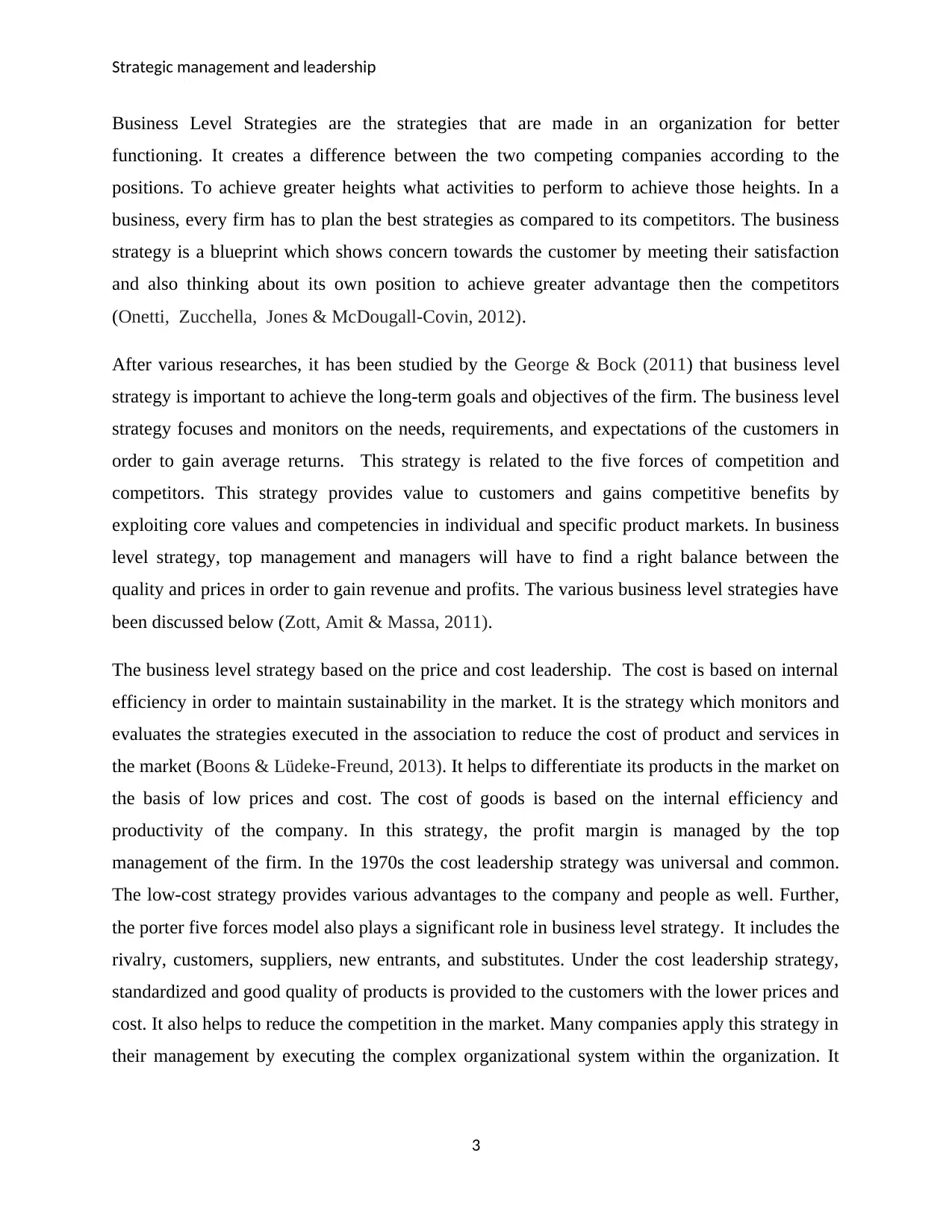
Strategic management and leadership
Business Level Strategies are the strategies that are made in an organization for better
functioning. It creates a difference between the two competing companies according to the
positions. To achieve greater heights what activities to perform to achieve those heights. In a
business, every firm has to plan the best strategies as compared to its competitors. The business
strategy is a blueprint which shows concern towards the customer by meeting their satisfaction
and also thinking about its own position to achieve greater advantage then the competitors
(Onetti, Zucchella, Jones & McDougall-Covin, 2012).
After various researches, it has been studied by the George & Bock (2011) that business level
strategy is important to achieve the long-term goals and objectives of the firm. The business level
strategy focuses and monitors on the needs, requirements, and expectations of the customers in
order to gain average returns. This strategy is related to the five forces of competition and
competitors. This strategy provides value to customers and gains competitive benefits by
exploiting core values and competencies in individual and specific product markets. In business
level strategy, top management and managers will have to find a right balance between the
quality and prices in order to gain revenue and profits. The various business level strategies have
been discussed below (Zott, Amit & Massa, 2011).
The business level strategy based on the price and cost leadership. The cost is based on internal
efficiency in order to maintain sustainability in the market. It is the strategy which monitors and
evaluates the strategies executed in the association to reduce the cost of product and services in
the market (Boons & Lüdeke-Freund, 2013). It helps to differentiate its products in the market on
the basis of low prices and cost. The cost of goods is based on the internal efficiency and
productivity of the company. In this strategy, the profit margin is managed by the top
management of the firm. In the 1970s the cost leadership strategy was universal and common.
The low-cost strategy provides various advantages to the company and people as well. Further,
the porter five forces model also plays a significant role in business level strategy. It includes the
rivalry, customers, suppliers, new entrants, and substitutes. Under the cost leadership strategy,
standardized and good quality of products is provided to the customers with the lower prices and
cost. It also helps to reduce the competition in the market. Many companies apply this strategy in
their management by executing the complex organizational system within the organization. It
3
Business Level Strategies are the strategies that are made in an organization for better
functioning. It creates a difference between the two competing companies according to the
positions. To achieve greater heights what activities to perform to achieve those heights. In a
business, every firm has to plan the best strategies as compared to its competitors. The business
strategy is a blueprint which shows concern towards the customer by meeting their satisfaction
and also thinking about its own position to achieve greater advantage then the competitors
(Onetti, Zucchella, Jones & McDougall-Covin, 2012).
After various researches, it has been studied by the George & Bock (2011) that business level
strategy is important to achieve the long-term goals and objectives of the firm. The business level
strategy focuses and monitors on the needs, requirements, and expectations of the customers in
order to gain average returns. This strategy is related to the five forces of competition and
competitors. This strategy provides value to customers and gains competitive benefits by
exploiting core values and competencies in individual and specific product markets. In business
level strategy, top management and managers will have to find a right balance between the
quality and prices in order to gain revenue and profits. The various business level strategies have
been discussed below (Zott, Amit & Massa, 2011).
The business level strategy based on the price and cost leadership. The cost is based on internal
efficiency in order to maintain sustainability in the market. It is the strategy which monitors and
evaluates the strategies executed in the association to reduce the cost of product and services in
the market (Boons & Lüdeke-Freund, 2013). It helps to differentiate its products in the market on
the basis of low prices and cost. The cost of goods is based on the internal efficiency and
productivity of the company. In this strategy, the profit margin is managed by the top
management of the firm. In the 1970s the cost leadership strategy was universal and common.
The low-cost strategy provides various advantages to the company and people as well. Further,
the porter five forces model also plays a significant role in business level strategy. It includes the
rivalry, customers, suppliers, new entrants, and substitutes. Under the cost leadership strategy,
standardized and good quality of products is provided to the customers with the lower prices and
cost. It also helps to reduce the competition in the market. Many companies apply this strategy in
their management by executing the complex organizational system within the organization. It
3
⊘ This is a preview!⊘
Do you want full access?
Subscribe today to unlock all pages.

Trusted by 1+ million students worldwide
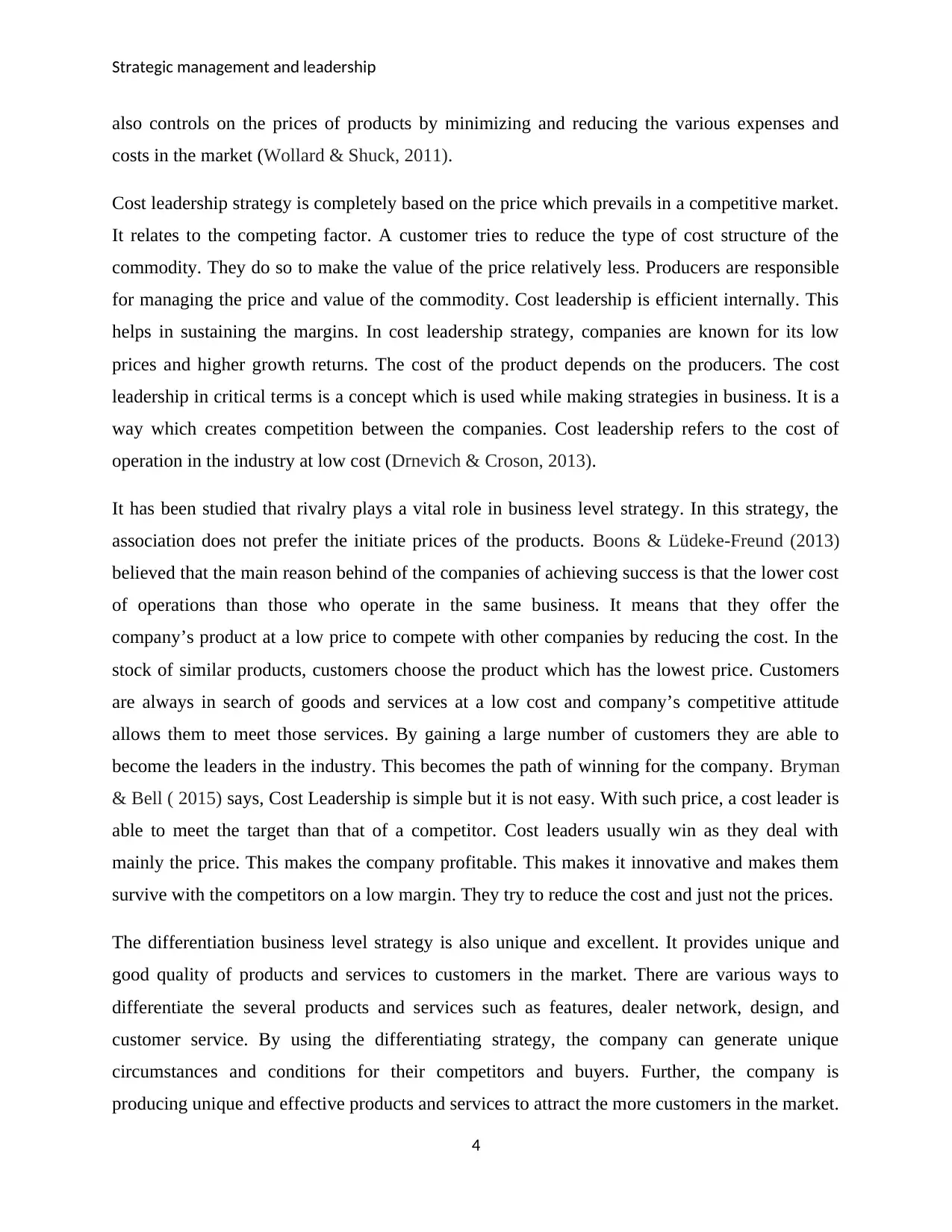
Strategic management and leadership
also controls on the prices of products by minimizing and reducing the various expenses and
costs in the market (Wollard & Shuck, 2011).
Cost leadership strategy is completely based on the price which prevails in a competitive market.
It relates to the competing factor. A customer tries to reduce the type of cost structure of the
commodity. They do so to make the value of the price relatively less. Producers are responsible
for managing the price and value of the commodity. Cost leadership is efficient internally. This
helps in sustaining the margins. In cost leadership strategy, companies are known for its low
prices and higher growth returns. The cost of the product depends on the producers. The cost
leadership in critical terms is a concept which is used while making strategies in business. It is a
way which creates competition between the companies. Cost leadership refers to the cost of
operation in the industry at low cost (Drnevich & Croson, 2013).
It has been studied that rivalry plays a vital role in business level strategy. In this strategy, the
association does not prefer the initiate prices of the products. Boons & Lüdeke-Freund (2013)
believed that the main reason behind of the companies of achieving success is that the lower cost
of operations than those who operate in the same business. It means that they offer the
company’s product at a low price to compete with other companies by reducing the cost. In the
stock of similar products, customers choose the product which has the lowest price. Customers
are always in search of goods and services at a low cost and company’s competitive attitude
allows them to meet those services. By gaining a large number of customers they are able to
become the leaders in the industry. This becomes the path of winning for the company. Bryman
& Bell ( 2015) says, Cost Leadership is simple but it is not easy. With such price, a cost leader is
able to meet the target than that of a competitor. Cost leaders usually win as they deal with
mainly the price. This makes the company profitable. This makes it innovative and makes them
survive with the competitors on a low margin. They try to reduce the cost and just not the prices.
The differentiation business level strategy is also unique and excellent. It provides unique and
good quality of products and services to customers in the market. There are various ways to
differentiate the several products and services such as features, dealer network, design, and
customer service. By using the differentiating strategy, the company can generate unique
circumstances and conditions for their competitors and buyers. Further, the company is
producing unique and effective products and services to attract the more customers in the market.
4
also controls on the prices of products by minimizing and reducing the various expenses and
costs in the market (Wollard & Shuck, 2011).
Cost leadership strategy is completely based on the price which prevails in a competitive market.
It relates to the competing factor. A customer tries to reduce the type of cost structure of the
commodity. They do so to make the value of the price relatively less. Producers are responsible
for managing the price and value of the commodity. Cost leadership is efficient internally. This
helps in sustaining the margins. In cost leadership strategy, companies are known for its low
prices and higher growth returns. The cost of the product depends on the producers. The cost
leadership in critical terms is a concept which is used while making strategies in business. It is a
way which creates competition between the companies. Cost leadership refers to the cost of
operation in the industry at low cost (Drnevich & Croson, 2013).
It has been studied that rivalry plays a vital role in business level strategy. In this strategy, the
association does not prefer the initiate prices of the products. Boons & Lüdeke-Freund (2013)
believed that the main reason behind of the companies of achieving success is that the lower cost
of operations than those who operate in the same business. It means that they offer the
company’s product at a low price to compete with other companies by reducing the cost. In the
stock of similar products, customers choose the product which has the lowest price. Customers
are always in search of goods and services at a low cost and company’s competitive attitude
allows them to meet those services. By gaining a large number of customers they are able to
become the leaders in the industry. This becomes the path of winning for the company. Bryman
& Bell ( 2015) says, Cost Leadership is simple but it is not easy. With such price, a cost leader is
able to meet the target than that of a competitor. Cost leaders usually win as they deal with
mainly the price. This makes the company profitable. This makes it innovative and makes them
survive with the competitors on a low margin. They try to reduce the cost and just not the prices.
The differentiation business level strategy is also unique and excellent. It provides unique and
good quality of products and services to customers in the market. There are various ways to
differentiate the several products and services such as features, dealer network, design, and
customer service. By using the differentiating strategy, the company can generate unique
circumstances and conditions for their competitors and buyers. Further, the company is
producing unique and effective products and services to attract the more customers in the market.
4
Paraphrase This Document
Need a fresh take? Get an instant paraphrase of this document with our AI Paraphraser
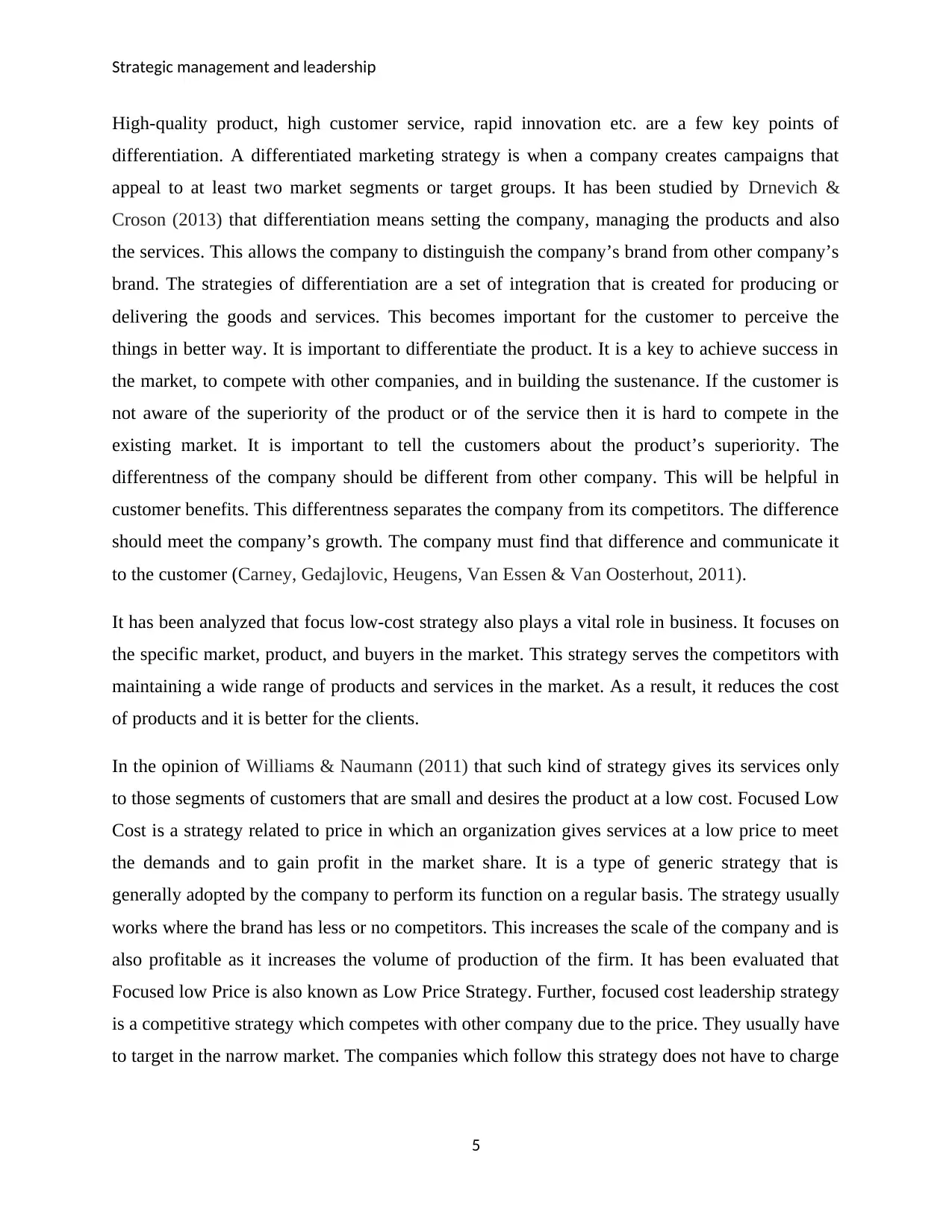
Strategic management and leadership
High-quality product, high customer service, rapid innovation etc. are a few key points of
differentiation. A differentiated marketing strategy is when a company creates campaigns that
appeal to at least two market segments or target groups. It has been studied by Drnevich &
Croson (2013) that differentiation means setting the company, managing the products and also
the services. This allows the company to distinguish the company’s brand from other company’s
brand. The strategies of differentiation are a set of integration that is created for producing or
delivering the goods and services. This becomes important for the customer to perceive the
things in better way. It is important to differentiate the product. It is a key to achieve success in
the market, to compete with other companies, and in building the sustenance. If the customer is
not aware of the superiority of the product or of the service then it is hard to compete in the
existing market. It is important to tell the customers about the product’s superiority. The
differentness of the company should be different from other company. This will be helpful in
customer benefits. This differentness separates the company from its competitors. The difference
should meet the company’s growth. The company must find that difference and communicate it
to the customer (Carney, Gedajlovic, Heugens, Van Essen & Van Oosterhout, 2011).
It has been analyzed that focus low-cost strategy also plays a vital role in business. It focuses on
the specific market, product, and buyers in the market. This strategy serves the competitors with
maintaining a wide range of products and services in the market. As a result, it reduces the cost
of products and it is better for the clients.
In the opinion of Williams & Naumann (2011) that such kind of strategy gives its services only
to those segments of customers that are small and desires the product at a low cost. Focused Low
Cost is a strategy related to price in which an organization gives services at a low price to meet
the demands and to gain profit in the market share. It is a type of generic strategy that is
generally adopted by the company to perform its function on a regular basis. The strategy usually
works where the brand has less or no competitors. This increases the scale of the company and is
also profitable as it increases the volume of production of the firm. It has been evaluated that
Focused low Price is also known as Low Price Strategy. Further, focused cost leadership strategy
is a competitive strategy which competes with other company due to the price. They usually have
to target in the narrow market. The companies which follow this strategy does not have to charge
5
High-quality product, high customer service, rapid innovation etc. are a few key points of
differentiation. A differentiated marketing strategy is when a company creates campaigns that
appeal to at least two market segments or target groups. It has been studied by Drnevich &
Croson (2013) that differentiation means setting the company, managing the products and also
the services. This allows the company to distinguish the company’s brand from other company’s
brand. The strategies of differentiation are a set of integration that is created for producing or
delivering the goods and services. This becomes important for the customer to perceive the
things in better way. It is important to differentiate the product. It is a key to achieve success in
the market, to compete with other companies, and in building the sustenance. If the customer is
not aware of the superiority of the product or of the service then it is hard to compete in the
existing market. It is important to tell the customers about the product’s superiority. The
differentness of the company should be different from other company. This will be helpful in
customer benefits. This differentness separates the company from its competitors. The difference
should meet the company’s growth. The company must find that difference and communicate it
to the customer (Carney, Gedajlovic, Heugens, Van Essen & Van Oosterhout, 2011).
It has been analyzed that focus low-cost strategy also plays a vital role in business. It focuses on
the specific market, product, and buyers in the market. This strategy serves the competitors with
maintaining a wide range of products and services in the market. As a result, it reduces the cost
of products and it is better for the clients.
In the opinion of Williams & Naumann (2011) that such kind of strategy gives its services only
to those segments of customers that are small and desires the product at a low cost. Focused Low
Cost is a strategy related to price in which an organization gives services at a low price to meet
the demands and to gain profit in the market share. It is a type of generic strategy that is
generally adopted by the company to perform its function on a regular basis. The strategy usually
works where the brand has less or no competitors. This increases the scale of the company and is
also profitable as it increases the volume of production of the firm. It has been evaluated that
Focused low Price is also known as Low Price Strategy. Further, focused cost leadership strategy
is a competitive strategy which competes with other company due to the price. They usually have
to target in the narrow market. The companies which follow this strategy does not have to charge
5
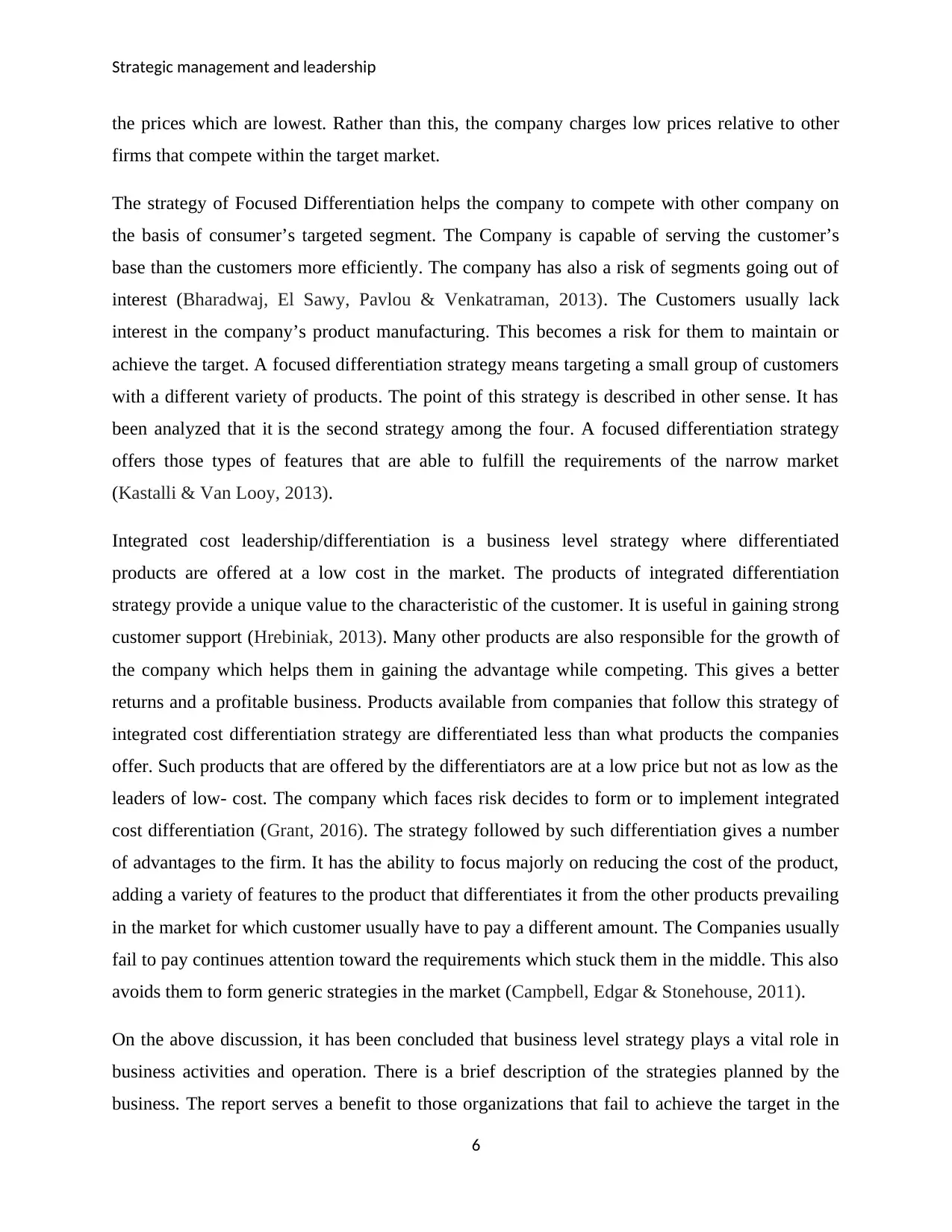
Strategic management and leadership
the prices which are lowest. Rather than this, the company charges low prices relative to other
firms that compete within the target market.
The strategy of Focused Differentiation helps the company to compete with other company on
the basis of consumer’s targeted segment. The Company is capable of serving the customer’s
base than the customers more efficiently. The company has also a risk of segments going out of
interest (Bharadwaj, El Sawy, Pavlou & Venkatraman, 2013). The Customers usually lack
interest in the company’s product manufacturing. This becomes a risk for them to maintain or
achieve the target. A focused differentiation strategy means targeting a small group of customers
with a different variety of products. The point of this strategy is described in other sense. It has
been analyzed that it is the second strategy among the four. A focused differentiation strategy
offers those types of features that are able to fulfill the requirements of the narrow market
(Kastalli & Van Looy, 2013).
Integrated cost leadership/differentiation is a business level strategy where differentiated
products are offered at a low cost in the market. The products of integrated differentiation
strategy provide a unique value to the characteristic of the customer. It is useful in gaining strong
customer support (Hrebiniak, 2013). Many other products are also responsible for the growth of
the company which helps them in gaining the advantage while competing. This gives a better
returns and a profitable business. Products available from companies that follow this strategy of
integrated cost differentiation strategy are differentiated less than what products the companies
offer. Such products that are offered by the differentiators are at a low price but not as low as the
leaders of low- cost. The company which faces risk decides to form or to implement integrated
cost differentiation (Grant, 2016). The strategy followed by such differentiation gives a number
of advantages to the firm. It has the ability to focus majorly on reducing the cost of the product,
adding a variety of features to the product that differentiates it from the other products prevailing
in the market for which customer usually have to pay a different amount. The Companies usually
fail to pay continues attention toward the requirements which stuck them in the middle. This also
avoids them to form generic strategies in the market (Campbell, Edgar & Stonehouse, 2011).
On the above discussion, it has been concluded that business level strategy plays a vital role in
business activities and operation. There is a brief description of the strategies planned by the
business. The report serves a benefit to those organizations that fail to achieve the target in the
6
the prices which are lowest. Rather than this, the company charges low prices relative to other
firms that compete within the target market.
The strategy of Focused Differentiation helps the company to compete with other company on
the basis of consumer’s targeted segment. The Company is capable of serving the customer’s
base than the customers more efficiently. The company has also a risk of segments going out of
interest (Bharadwaj, El Sawy, Pavlou & Venkatraman, 2013). The Customers usually lack
interest in the company’s product manufacturing. This becomes a risk for them to maintain or
achieve the target. A focused differentiation strategy means targeting a small group of customers
with a different variety of products. The point of this strategy is described in other sense. It has
been analyzed that it is the second strategy among the four. A focused differentiation strategy
offers those types of features that are able to fulfill the requirements of the narrow market
(Kastalli & Van Looy, 2013).
Integrated cost leadership/differentiation is a business level strategy where differentiated
products are offered at a low cost in the market. The products of integrated differentiation
strategy provide a unique value to the characteristic of the customer. It is useful in gaining strong
customer support (Hrebiniak, 2013). Many other products are also responsible for the growth of
the company which helps them in gaining the advantage while competing. This gives a better
returns and a profitable business. Products available from companies that follow this strategy of
integrated cost differentiation strategy are differentiated less than what products the companies
offer. Such products that are offered by the differentiators are at a low price but not as low as the
leaders of low- cost. The company which faces risk decides to form or to implement integrated
cost differentiation (Grant, 2016). The strategy followed by such differentiation gives a number
of advantages to the firm. It has the ability to focus majorly on reducing the cost of the product,
adding a variety of features to the product that differentiates it from the other products prevailing
in the market for which customer usually have to pay a different amount. The Companies usually
fail to pay continues attention toward the requirements which stuck them in the middle. This also
avoids them to form generic strategies in the market (Campbell, Edgar & Stonehouse, 2011).
On the above discussion, it has been concluded that business level strategy plays a vital role in
business activities and operation. There is a brief description of the strategies planned by the
business. The report serves a benefit to those organizations that fail to achieve the target in the
6
⊘ This is a preview!⊘
Do you want full access?
Subscribe today to unlock all pages.

Trusted by 1+ million students worldwide
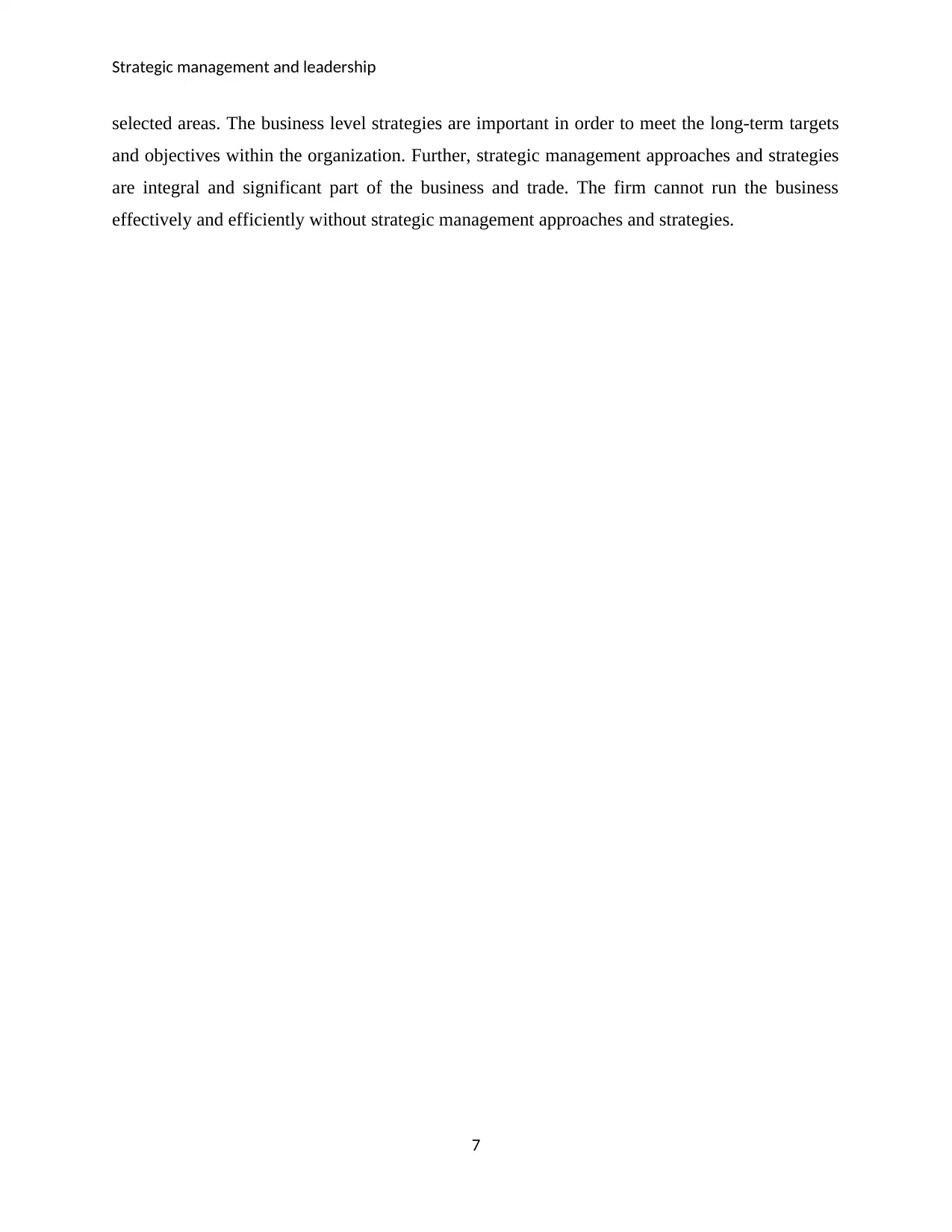
Strategic management and leadership
selected areas. The business level strategies are important in order to meet the long-term targets
and objectives within the organization. Further, strategic management approaches and strategies
are integral and significant part of the business and trade. The firm cannot run the business
effectively and efficiently without strategic management approaches and strategies.
7
selected areas. The business level strategies are important in order to meet the long-term targets
and objectives within the organization. Further, strategic management approaches and strategies
are integral and significant part of the business and trade. The firm cannot run the business
effectively and efficiently without strategic management approaches and strategies.
7
Paraphrase This Document
Need a fresh take? Get an instant paraphrase of this document with our AI Paraphraser
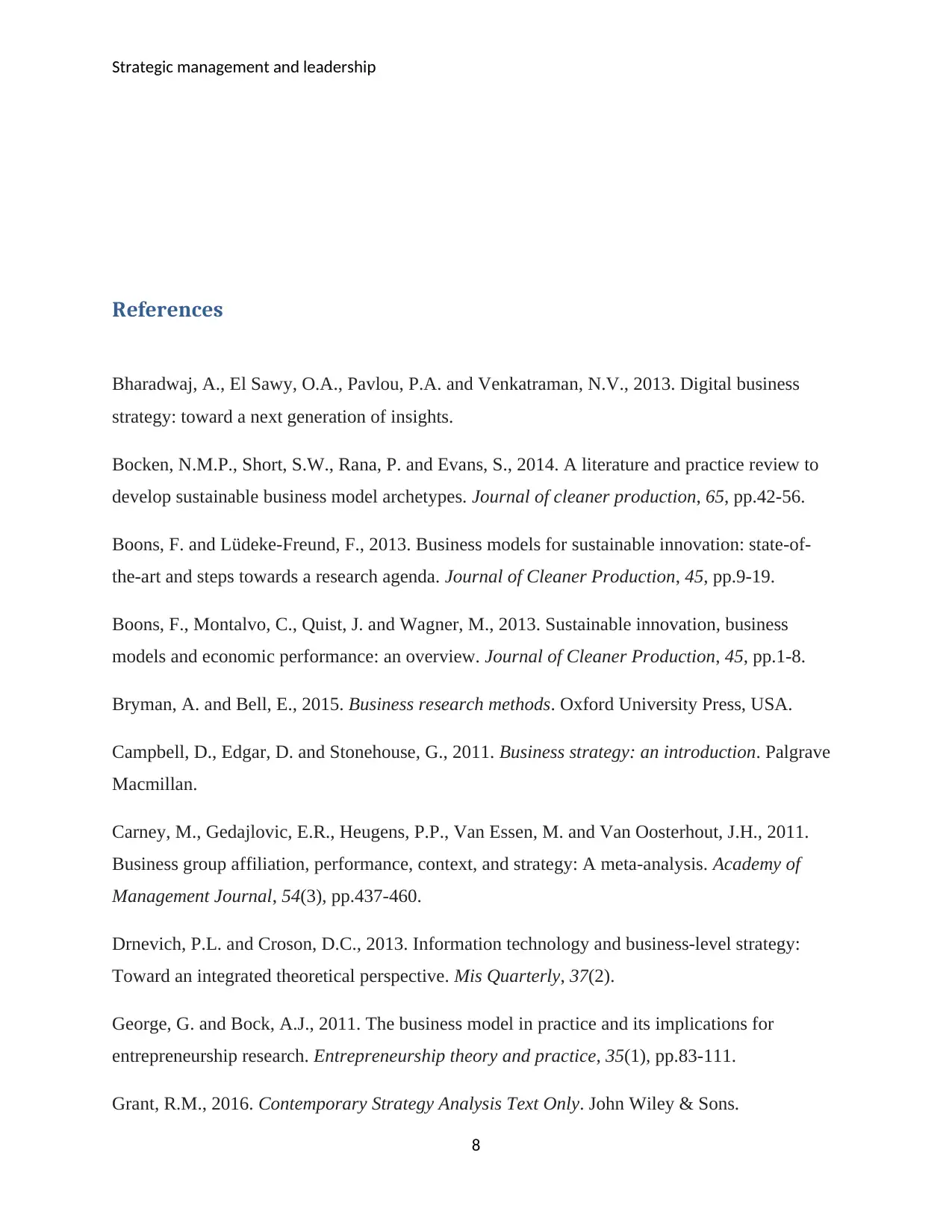
Strategic management and leadership
References
Bharadwaj, A., El Sawy, O.A., Pavlou, P.A. and Venkatraman, N.V., 2013. Digital business
strategy: toward a next generation of insights.
Bocken, N.M.P., Short, S.W., Rana, P. and Evans, S., 2014. A literature and practice review to
develop sustainable business model archetypes. Journal of cleaner production, 65, pp.42-56.
Boons, F. and Lüdeke-Freund, F., 2013. Business models for sustainable innovation: state-of-
the-art and steps towards a research agenda. Journal of Cleaner Production, 45, pp.9-19.
Boons, F., Montalvo, C., Quist, J. and Wagner, M., 2013. Sustainable innovation, business
models and economic performance: an overview. Journal of Cleaner Production, 45, pp.1-8.
Bryman, A. and Bell, E., 2015. Business research methods. Oxford University Press, USA.
Campbell, D., Edgar, D. and Stonehouse, G., 2011. Business strategy: an introduction. Palgrave
Macmillan.
Carney, M., Gedajlovic, E.R., Heugens, P.P., Van Essen, M. and Van Oosterhout, J.H., 2011.
Business group affiliation, performance, context, and strategy: A meta-analysis. Academy of
Management Journal, 54(3), pp.437-460.
Drnevich, P.L. and Croson, D.C., 2013. Information technology and business-level strategy:
Toward an integrated theoretical perspective. Mis Quarterly, 37(2).
George, G. and Bock, A.J., 2011. The business model in practice and its implications for
entrepreneurship research. Entrepreneurship theory and practice, 35(1), pp.83-111.
Grant, R.M., 2016. Contemporary Strategy Analysis Text Only. John Wiley & Sons.
8
References
Bharadwaj, A., El Sawy, O.A., Pavlou, P.A. and Venkatraman, N.V., 2013. Digital business
strategy: toward a next generation of insights.
Bocken, N.M.P., Short, S.W., Rana, P. and Evans, S., 2014. A literature and practice review to
develop sustainable business model archetypes. Journal of cleaner production, 65, pp.42-56.
Boons, F. and Lüdeke-Freund, F., 2013. Business models for sustainable innovation: state-of-
the-art and steps towards a research agenda. Journal of Cleaner Production, 45, pp.9-19.
Boons, F., Montalvo, C., Quist, J. and Wagner, M., 2013. Sustainable innovation, business
models and economic performance: an overview. Journal of Cleaner Production, 45, pp.1-8.
Bryman, A. and Bell, E., 2015. Business research methods. Oxford University Press, USA.
Campbell, D., Edgar, D. and Stonehouse, G., 2011. Business strategy: an introduction. Palgrave
Macmillan.
Carney, M., Gedajlovic, E.R., Heugens, P.P., Van Essen, M. and Van Oosterhout, J.H., 2011.
Business group affiliation, performance, context, and strategy: A meta-analysis. Academy of
Management Journal, 54(3), pp.437-460.
Drnevich, P.L. and Croson, D.C., 2013. Information technology and business-level strategy:
Toward an integrated theoretical perspective. Mis Quarterly, 37(2).
George, G. and Bock, A.J., 2011. The business model in practice and its implications for
entrepreneurship research. Entrepreneurship theory and practice, 35(1), pp.83-111.
Grant, R.M., 2016. Contemporary Strategy Analysis Text Only. John Wiley & Sons.
8
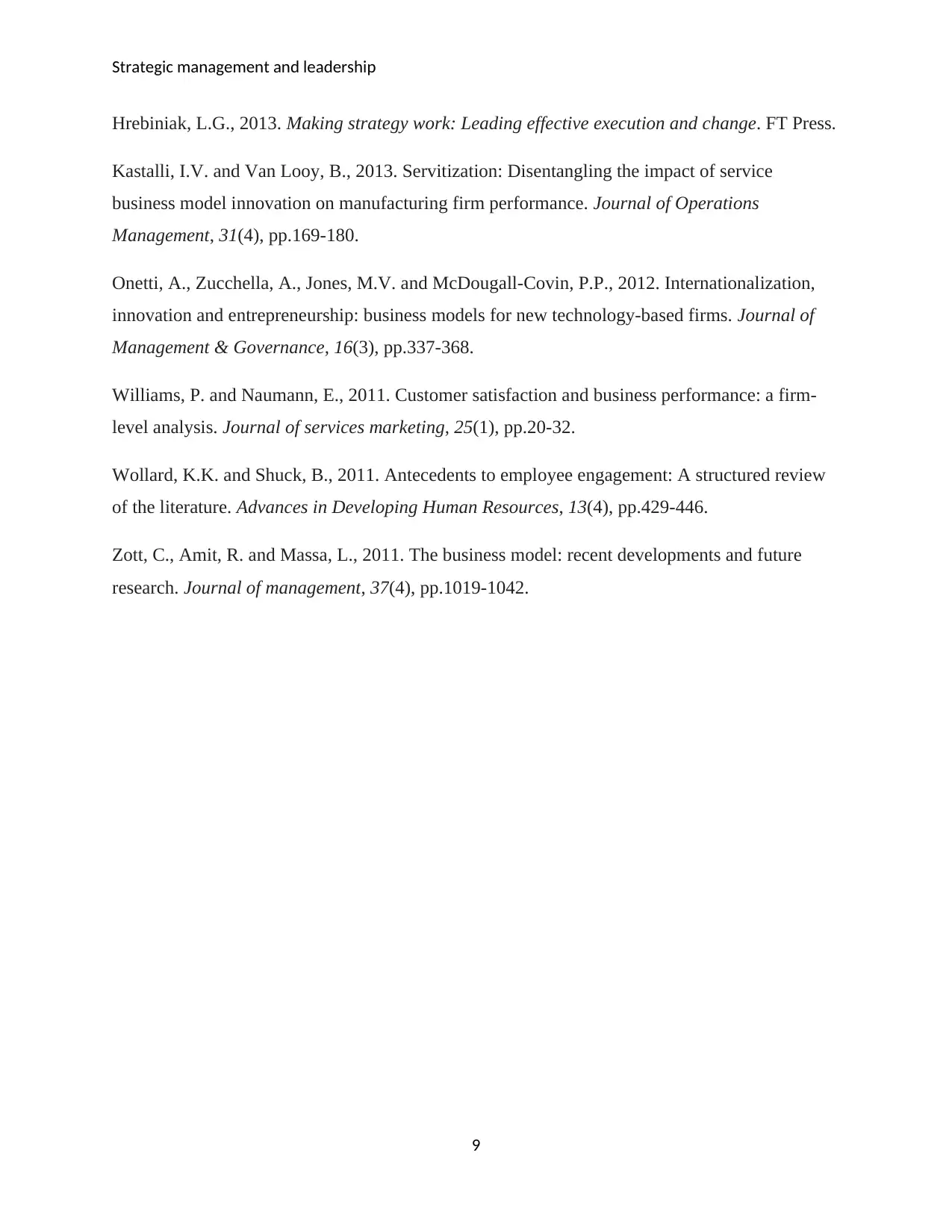
Strategic management and leadership
Hrebiniak, L.G., 2013. Making strategy work: Leading effective execution and change. FT Press.
Kastalli, I.V. and Van Looy, B., 2013. Servitization: Disentangling the impact of service
business model innovation on manufacturing firm performance. Journal of Operations
Management, 31(4), pp.169-180.
Onetti, A., Zucchella, A., Jones, M.V. and McDougall-Covin, P.P., 2012. Internationalization,
innovation and entrepreneurship: business models for new technology-based firms. Journal of
Management & Governance, 16(3), pp.337-368.
Williams, P. and Naumann, E., 2011. Customer satisfaction and business performance: a firm-
level analysis. Journal of services marketing, 25(1), pp.20-32.
Wollard, K.K. and Shuck, B., 2011. Antecedents to employee engagement: A structured review
of the literature. Advances in Developing Human Resources, 13(4), pp.429-446.
Zott, C., Amit, R. and Massa, L., 2011. The business model: recent developments and future
research. Journal of management, 37(4), pp.1019-1042.
9
Hrebiniak, L.G., 2013. Making strategy work: Leading effective execution and change. FT Press.
Kastalli, I.V. and Van Looy, B., 2013. Servitization: Disentangling the impact of service
business model innovation on manufacturing firm performance. Journal of Operations
Management, 31(4), pp.169-180.
Onetti, A., Zucchella, A., Jones, M.V. and McDougall-Covin, P.P., 2012. Internationalization,
innovation and entrepreneurship: business models for new technology-based firms. Journal of
Management & Governance, 16(3), pp.337-368.
Williams, P. and Naumann, E., 2011. Customer satisfaction and business performance: a firm-
level analysis. Journal of services marketing, 25(1), pp.20-32.
Wollard, K.K. and Shuck, B., 2011. Antecedents to employee engagement: A structured review
of the literature. Advances in Developing Human Resources, 13(4), pp.429-446.
Zott, C., Amit, R. and Massa, L., 2011. The business model: recent developments and future
research. Journal of management, 37(4), pp.1019-1042.
9
⊘ This is a preview!⊘
Do you want full access?
Subscribe today to unlock all pages.

Trusted by 1+ million students worldwide
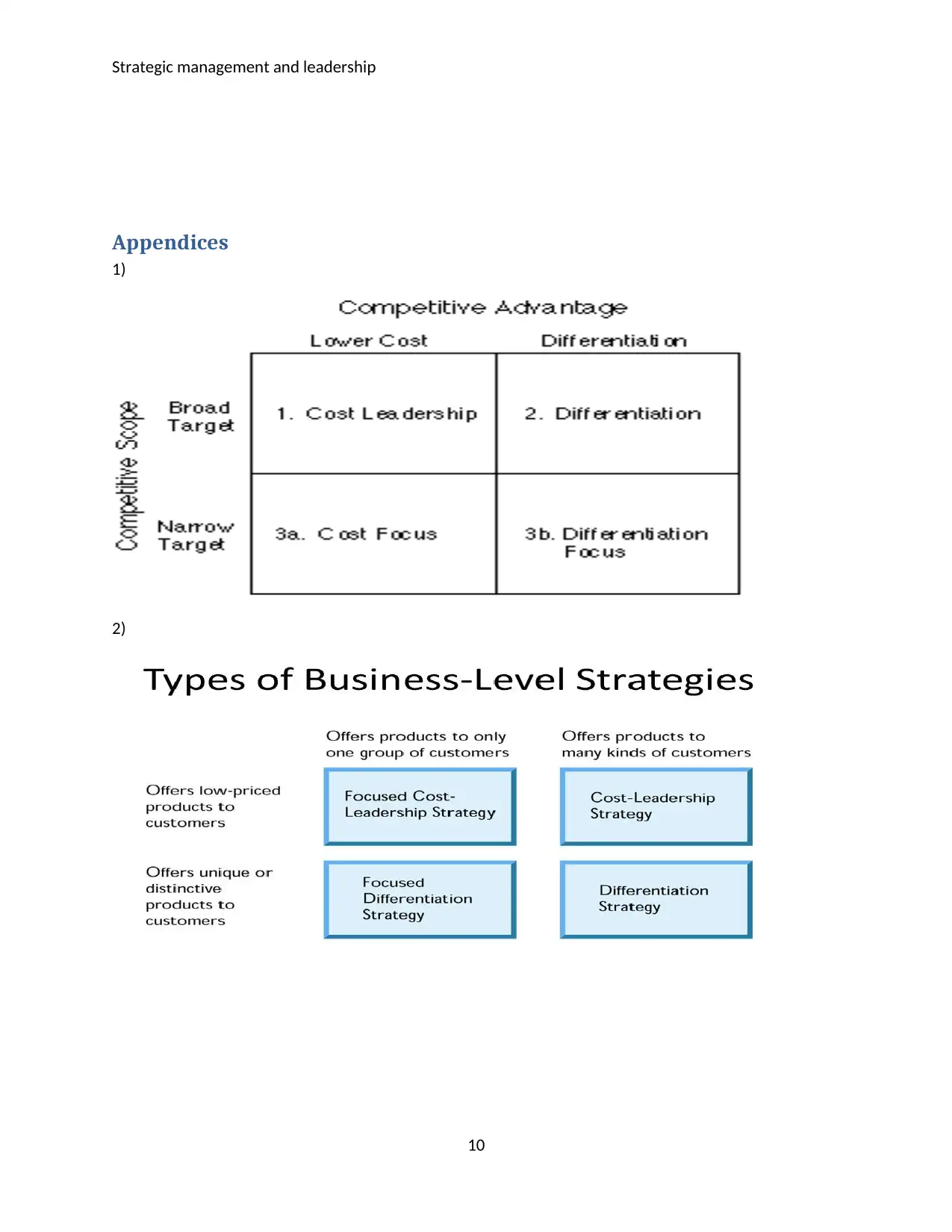
Strategic management and leadership
Appendices
1)
2)
10
Appendices
1)
2)
10
Paraphrase This Document
Need a fresh take? Get an instant paraphrase of this document with our AI Paraphraser
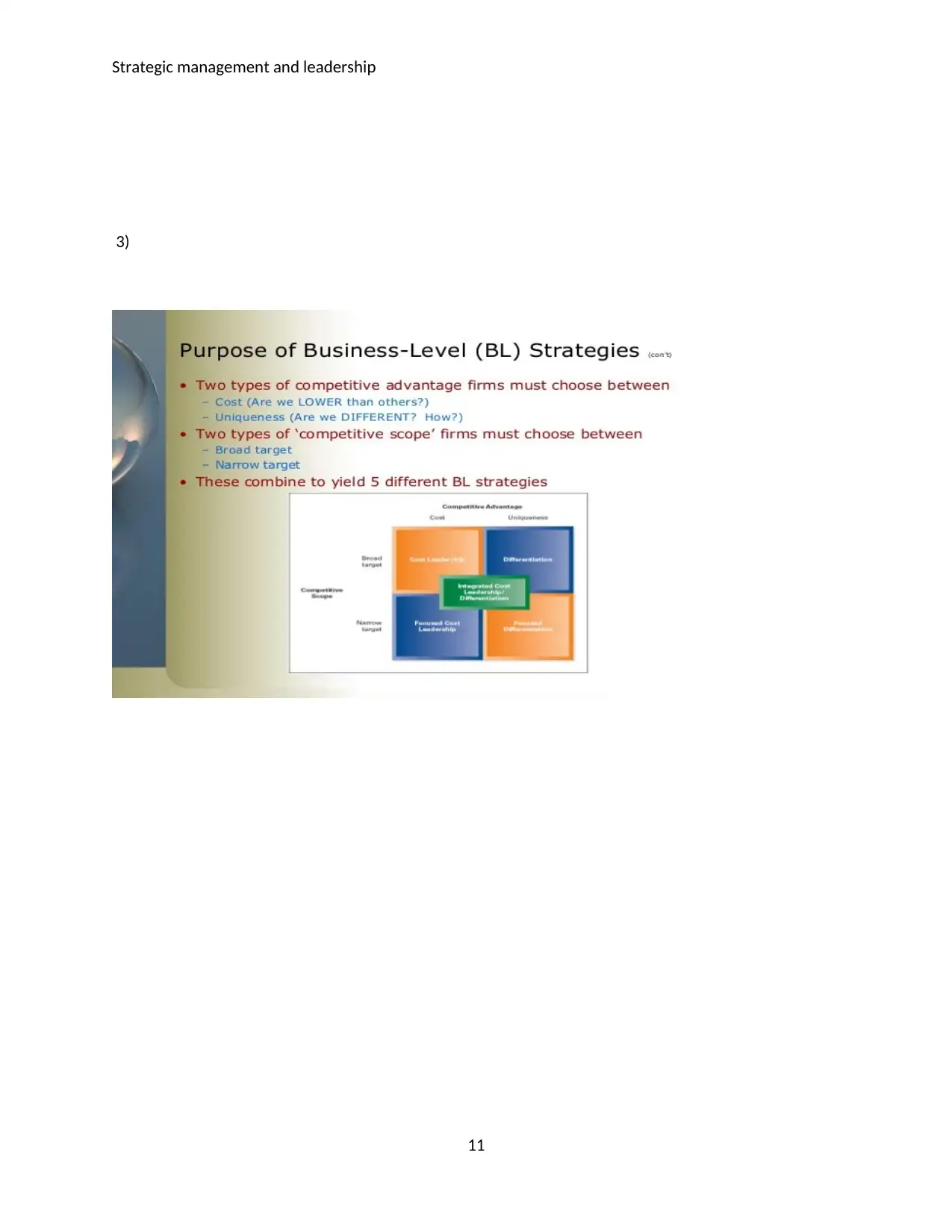
Strategic management and leadership
3)
11
3)
11
1 out of 11
Related Documents
Your All-in-One AI-Powered Toolkit for Academic Success.
+13062052269
info@desklib.com
Available 24*7 on WhatsApp / Email
![[object Object]](/_next/static/media/star-bottom.7253800d.svg)
Unlock your academic potential
Copyright © 2020–2025 A2Z Services. All Rights Reserved. Developed and managed by ZUCOL.





